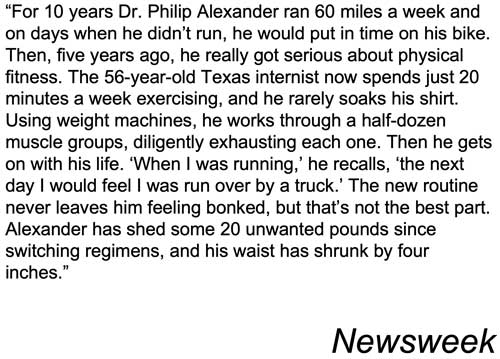Don't diet. Change your life. Commit now. Every day you don't is a day lost, and you're that much farther behind. – Dr. Philip Alexander
We're excited and honored to have the opportunity to publish a Kindle version of Dr. Philip Alexander's book on high intensity exercise!
The book is super simple, concise, and easy to read— providing an understanding of the principles behind high intensity exercise that you can read and digest in 20-minutes.
Even if you're already hip to the benefits of high intensity exercise, this book is a great refresher. Dr. Alexander has a unique way of simplifying the essential points.
About the Author
Some excerpts from the book:
Notice the * items above. Those are the famous Biomarkers of Aging. The more of them that worsen, the “older” you are medically. The common denominator to them all is the amount of muscle mass we have, or don't have. As we get older, we steadily lose muscle. Without strength-building exercise, all of those get worse as we age.
Watch this video to learn how we use ARX to safely provide the benefits of high intensity exercise in minutes a week.
On Calories…
It's not the calories burned DURING exercise. It's the calories burned AS A RESULT OF exercise. This is an important concept. If you walk or run a mile, that's about 100 calories. And there are about 3500 calories in a pound of fat. So, if you're planning to “burn off” a pound of fat, get ready to walk 35 miles.
The more efficient way is to add muscle. If you add 3 lbs. of muscle, that takes an extra 300 calories a day just to keep alive. You do the math, but that's 9000 calories a month. That's a lot of walking. And, you have just defined raising your metabolic rate.
On Age-Related Muscle Loss (Sarcopenia – absent strength training we lose as much as 5% of our muscle mass each decade after age 30)…
We have all told our patients that just performing activities of daily life (walking, taking the stairs, yard work) can preserve our cardiovascular health. Unfortunately, the age-related loss of muscle (sarcopenia) can undermine our ability to carry out those activities. Resistance training can prevent and even reverse sarcopenia. Furthermore, as a muscle becomes stronger, fewer motor units will have to be recruited to perform a given task, thus reducing the demand on the cardiovascular system. Clearly, the best kind of exercise is the kind that will tax the musculature the most, that will create a powerful cardiovascular stimulus, while producing hemodynamic changes that minimize the risk of cardiac ischemia and also produce the most profound peripheral changes in the form of muscle strengthening.
Grab a copy of the book on Amazon.com!
Subscribe To Real-Time Updates
Recommended Reading
Is Alcohol Okay on Training Days?
Consuming alcohol following resistance exercise could potentially hamper the desired muscular adaptations by reducing anabolic signaling.
8 Reasons You Should You Lift Weights
According to the research, one of the best things you can do for your health and body composition is strength training.
Isometric Exercise Using ARX
The beauty of ARX is we can do only concentric loads (the positive portion of the range of motion) or isometric (static exercise/no movement).
How is 10 Minutes a Week Possible?
With ARX at Quantify Fitness you can achieve maximal results in strength, hypertrophy, and metabolic conditioning in 10 minutes a week.
Focus on Building Muscle
Want to improve your body composition? Put on some muscle and quit spending all your time on the treadmill!
Quantify Fitness in the News!
NewsChannel5 came by our smart gym to find out how a weekly 10 minute workout can really be that effective.
Watch Former NFL Tennessee Titan and Pro-Bowl Receiver Derrick Mason’s Reaction to His 6 Minute Workout
We had a blast showing Derrick Mason around the gym! And even more fun seeing his reaction to the 10 minute workout!
Will Missing a Workout Hurt My Progress?
We occasionally get asked whether missing a workout will hurt a client's progress.
What is Your Body’s Preferred Source of Energy?
What is your body's preferred source of energy is? The 1,600 calories of stored sugar or the 96,000 calories of stored fat?
How to Run Faster in 10 Minutes a Week
If you've ever wondered what the research says about how to run faster, recent studies confirm that runners who do strength training turn in faster times.
Country Music Diva + Dedication + Effective Exercise = Results
The superstar results country music diva Pam Tillis has made happen through hard work and effective exercise are nothing short of remarkable.
3 Essential Steps to Health and Longevity
Most of what you've been told about exercise and nutrition has been wrong. It's not about burning more calories and starving yourself.


